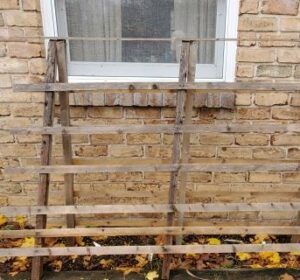HOW TO PLANT LETTUCE
The plant we’re going to talk about today is lettuce. How to plant leaf lettuce and how to care for leaf lettuce.
My favorite leaf lettuce is Buttercrunch or Red Sail. Although there are different kinds of lettuce, these two are my favorites.
Lettuce is a cool weather plant, meaning it does not like a lot of heat. Heat will cause the lettuce to “bolt” which means it grows flower-like blooms and gets strong and bitter. Lettuce grows best in full sun in loose, nitrogen-rich soils. You can also get a head start by planting seeds inside.
WHEN TO PLANT LETTUCE
As soon as we think we’ve gotten the last frost, we plant our leaf lettuce plants in a flower bed next to the house on the southern side of the house. It’s a good place to plant the first crop since it’s too early to plant flowers. If a very cold night is forecast, we cover them with old hanging flower pots that we saved from the year before. We are able to plant two crops before it gets too hot.
We also plant each group of six plants about two weeks apart so we can enjoy the lettuce for a longer period.
Once it starts growing, we have more lettuce than we can use. So our neighbors and relatives also enjoy our bounty.
HARVESTING THE LETTUCE
We pick the lettuce and leave the plants to continue producing. Some growers wait until the stalk is full and cut the entire stalk but we like the individual leaves. I put the leaves in ice water for a few minutes to clean it or run it under very cold water if I’m in a hurry. I purchased a lettuce dryer, then spin the water off the leaves, put the lettuce in Ziploc baggies, push most of the air out before closing the bag. The lettuce lasts for several days in the refrigerator.
DIFFERENT TYPES OF LETTUCE
There are several types of lettuce, but three (leaf, head and romaine) are the most common.
- Leaf lettuce – this type has loosely bunched leaves and is a very popular variety. It is used mainly for salads.
- Romaine lettuce – This is the most often used lettuce in Caesar salads. Used mainly for salads and sandwiches, this type forms long, upright heads.
- Iceberg lettuce – this is the most popular type in the US, it is low in flavor and nutritional value.
- Butterhead lettuce – Is known for its sweet flavor and tender texture. Also known as Boston or Bibb lettuce, this type is a head lettuce with a loose arrangement of leaves.
These are just a few of the different varieties of lettuce.
PESTS/INSECTS
Many insects are attracted to lettuce, including cutworms, wireworms, nematodes, aphids, leafhoppers, thrips, leafminers, and flea beetles. Our problems seem to come from the slugs and snails, which cut large holes in leaves. Rabbits and groundhogs, also eat the plants. We struggle with the rabbits but not so much with the groundhogs until we plant vegetables in the main garden. Then the groundhogs have a feast along with the rabbits.
That’s it for today.
CHECK BACK WITH US OFTEN FOR MORE…“ALL ABOUT PLANTS”.

 because we’re looking through the window screen.
because we’re looking through the window screen. the house and the fence where it got lodged. Here’s a picture of that poor cuke.
the house and the fence where it got lodged. Here’s a picture of that poor cuke.